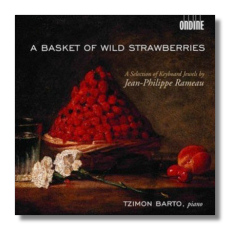
The Internet's Premier Classical Music Source
Related Links
- Rameau Reviews
- Latest Reviews
- More Reviews
-
By Composer
-
Collections
DVD & Blu-ray
Books
Concert Reviews
Articles/Interviews
Software
Audio
Search Amazon
Recommended Links
Site News
 CD Review
CD Review
Jean-Philippe Rameau
A Basket of Wild Strawberries

- Premier Livre (1706):
- Prélude
- Allemande
- Sarabandes I & II
- Gavotte
- Pièces de clavecin (1724) – Suite in E:
- Gigue en rondeau I & II
- Le Rappel des Oiseaux
- Rigadouns I & II
- Double du II
- Musette en rondeau
- Tambourin
- La Villageoise
- Pièces de clavecin (1724) – Suite in D:
- Les Tendres Plaintes
- Les Nais de Sologne & Deux Doubles
- Les Soupirs
- La Joyeuse
- Nouvelles Suites (1728) – Suite in A:
- Allemande
- Les Trois Mains
- Sarabande
- Fanfarinette
- La Triomphante
- Gavotte & Six Doubles
Tzimon Barto, piano
Ondine ODE1067-2 DDD 75:57
Tzimon Barto made several recordings for EMI Classics around 1990 and then fell out of prominence. (Even then, we needed another "Rach 3" like we needed a hole in the head.) He hasn't been slacking though – he's also poet and novelist – and this CD, recorded in 2005, presents Barto's pianism in a completely different light. (New to me, anyway.)
It also, I might add, presents Jean-Philippe Rameau in a completely different light! Rameau never intended his Pièces de clavecin to be played on a modern concert grand piano, because he never knew of such an instrument. He also never intended his music to be played as if it were from the nineteenth century, not the eighteenth. (Rameau died in 1764.) And yet, as his been shown over and over again with the music of Bach, Vivaldi, Handel, and others, Baroque music travels well. Barto's Romantic style will not appeal to some listeners, but if you believe that music doesn't always have to be played in an "authentic" style, then Barto's always interesting (if occasionally eyebrow-raising) readings have much to offer. For starters, go to "Les Niais de Sologne," a portrait of (depending on how you translate the title) jesters, fools, or acrobats. More than any other performer I know, Barto brings out the grotesquerie in this gangly little piece, accenting individual notes unexpectedly, and generally, well, playing the fool with it. Towards the end of the piece, he accelerates to what even he calls "an excessively fast tempo" that "just would not be possible on the harpsichord." (Possible? Yes. Intelligible? Probably not!) In the A-major Allemande from Nouvelle Suite, Barto makes time stop as he slowly deconstructs the poignant melody. (He also quietly hums along with it – shades of Glenn Gould.) In the booklet note interview, he expresses his opinion that ornamentation, while needed on the harpsichord to keep the melodic line connected, is much less necessary on the piano, where it is easier to play legato. For that reason, Barto ornaments little. Elsewhere, he recounts how his teacher at Juilliard would remind him not to play the piano like a harpsichord. That advice is very apparent in these generously pedaled and dynamically modulated readings. Romantic Rameau? Well, why not!
Not even the selection of works is traditional. Barto has picked-and-chosen four pieces from the Premier Livre of 1706, 11 from the Pièces de clavecin of 1724 (seven from the Suite in E Major and four from the Suite in D Major), and six from the Nouvelle Suite in A Major of 1728. It's a satisfying program, even though it's based on the pianist's personal preferences rather than on canonical musicology!
In the booklet note, Barto states, "This recording is a carnival, a fair of answers to questions about Rameau-interpretation." So true! He continues, "Depending on the piece, the answers are more or less satisfying." Fortunately, there are more hits than misses here. This is a very appealing collection of intrinsically evocative and forward-looking keyboard music, made even more evocative through Tzimon Barto's intelligence, and his unwillingness merely to imitate what others have done.
Copyright © 2006, Raymond Tuttle




















